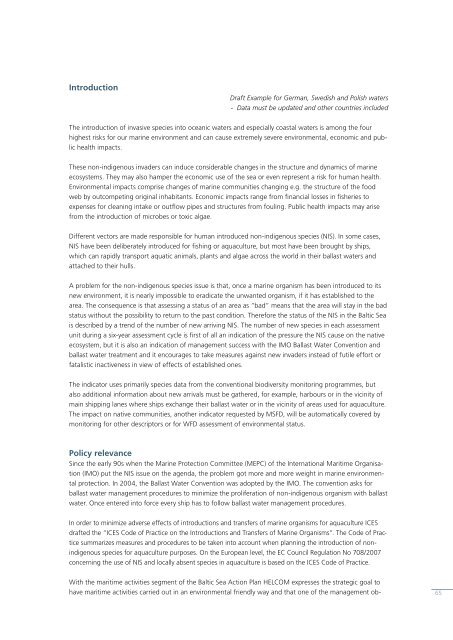Interim report of the HELCOM CORESET project
Interim report of the HELCOM CORESET project
Interim report of the HELCOM CORESET project
You also want an ePaper? Increase the reach of your titles
YUMPU automatically turns print PDFs into web optimized ePapers that Google loves.
Introduction<br />
Draft Example for German, Swedish and Polish waters<br />
- Data must be updated and o<strong>the</strong>r countries included<br />
The introduction <strong>of</strong> invasive species into oceanic waters and especially coastal waters is among <strong>the</strong> four<br />
highest risks for our marine environment and can cause extremely severe environmental, economic and public<br />
health impacts.<br />
These non-indigenous invaders can induce considerable changes in <strong>the</strong> structure and dynamics <strong>of</strong> marine<br />
ecosystems. They may also hamper <strong>the</strong> economic use <strong>of</strong> <strong>the</strong> sea or even represent a risk for human health.<br />
Environmental impacts comprise changes <strong>of</strong> marine communities changing e.g. <strong>the</strong> structure <strong>of</strong> <strong>the</strong> food<br />
web by outcompeting original inhabitants. Economic impacts range from fi nancial losses in fi sheries to<br />
expenses for cleaning intake or outfl ow pipes and structures from fouling. Public health impacts may arise<br />
from <strong>the</strong> introduction <strong>of</strong> microbes or toxic algae.<br />
Different vectors are made responsible for human introduced non-indigenous species (NIS). In some cases,<br />
NIS have been deliberately introduced for fi shing or aquaculture, but most have been brought by ships,<br />
which can rapidly transport aquatic animals, plants and algae across <strong>the</strong> world in <strong>the</strong>ir ballast waters and<br />
attached to <strong>the</strong>ir hulls.<br />
A problem for <strong>the</strong> non-indigenous species issue is that, once a marine organism has been introduced to its<br />
new environment, it is nearly impossible to eradicate <strong>the</strong> unwanted organism, if it has established to <strong>the</strong><br />
area. The consequence is that assessing a status <strong>of</strong> an area as “bad” means that <strong>the</strong> area will stay in <strong>the</strong> bad<br />
status without <strong>the</strong> possibility to return to <strong>the</strong> past condition. Therefore <strong>the</strong> status <strong>of</strong> <strong>the</strong> NIS in <strong>the</strong> Baltic Sea<br />
is described by a trend <strong>of</strong> <strong>the</strong> number <strong>of</strong> new arriving NIS. The number <strong>of</strong> new species in each assessment<br />
unit during a six-year assessment cycle is fi rst <strong>of</strong> all an indication <strong>of</strong> <strong>the</strong> pressure <strong>the</strong> NIS cause on <strong>the</strong> native<br />
ecosystem, but it is also an indication <strong>of</strong> management success with <strong>the</strong> IMO Ballast Water Convention and<br />
ballast water treatment and it encourages to take measures against new invaders instead <strong>of</strong> futile effort or<br />
fatalistic inactiveness in view <strong>of</strong> effects <strong>of</strong> established ones.<br />
The indicator uses primarily species data from <strong>the</strong> conventional biodiversity monitoring programmes, but<br />
also additional information about new arrivals must be ga<strong>the</strong>red, for example, harbours or in <strong>the</strong> vicinity <strong>of</strong><br />
main shipping lanes where ships exchange <strong>the</strong>ir ballast water or in <strong>the</strong> vicinity <strong>of</strong> areas used for aquaculture.<br />
The impact on native communities, ano<strong>the</strong>r indicator requested by MSFD, will be automatically covered by<br />
monitoring for o<strong>the</strong>r descriptors or for WFD assessment <strong>of</strong> environmental status.<br />
Policy relevance<br />
Since <strong>the</strong> early 90s when <strong>the</strong> Marine Protection Committee (MEPC) <strong>of</strong> <strong>the</strong> International Maritime Organisation<br />
(IMO) put <strong>the</strong> NIS issue on <strong>the</strong> agenda, <strong>the</strong> problem got more and more weight in marine environmental<br />
protection. In 2004, <strong>the</strong> Ballast Water Convention was adopted by <strong>the</strong> IMO. The convention asks for<br />
ballast water management procedures to minimize <strong>the</strong> proliferation <strong>of</strong> non-indigenous organism with ballast<br />
water. Once entered into force every ship has to follow ballast water management procedures.<br />
In order to minimize adverse effects <strong>of</strong> introductions and transfers <strong>of</strong> marine organisms for aquaculture ICES<br />
drafted <strong>the</strong> “ICES Code <strong>of</strong> Practice on <strong>the</strong> Introductions and Transfers <strong>of</strong> Marine Organisms”. The Code <strong>of</strong> Practice<br />
summarizes measures and procedures to be taken into account when planning <strong>the</strong> introduction <strong>of</strong> nonindigenous<br />
species for aquaculture purposes. On <strong>the</strong> European level, <strong>the</strong> EC Council Regulation No 708/2007<br />
concerning <strong>the</strong> use <strong>of</strong> NIS and locally absent species in aquaculture is based on <strong>the</strong> ICES Code <strong>of</strong> Practice.<br />
With <strong>the</strong> maritime activities segment <strong>of</strong> <strong>the</strong> Baltic Sea Action Plan <strong>HELCOM</strong> expresses <strong>the</strong> strategic goal to<br />
have maritime activities carried out in an environmental friendly way and that one <strong>of</strong> <strong>the</strong> management ob-<br />
65













